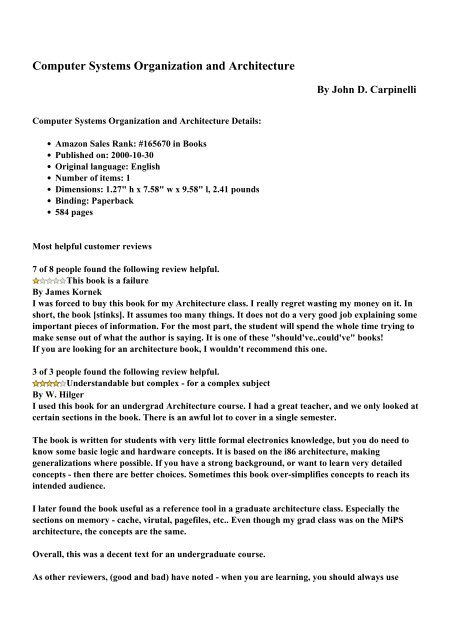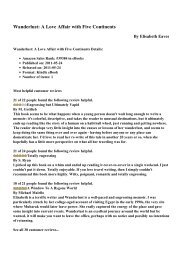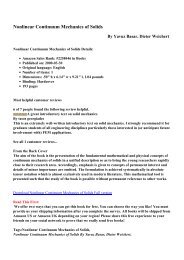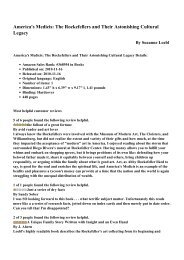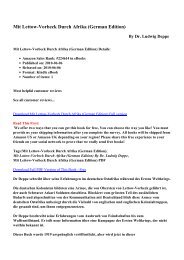John D. Carpinelli Computer Systems Organization and Architecture
John D. Carpinelli Computer Systems Organization and Architecture
John D. Carpinelli Computer Systems Organization and Architecture
You also want an ePaper? Increase the reach of your titles
YUMPU automatically turns print PDFs into web optimized ePapers that Google loves.
<strong>Computer</strong> <strong>Systems</strong> <strong>Organization</strong> <strong>and</strong> <strong>Architecture</strong><br />
By <strong>John</strong> D. <strong>Carpinelli</strong><br />
<strong>Computer</strong> <strong>Systems</strong> <strong>Organization</strong> <strong>and</strong> <strong>Architecture</strong> Details:<br />
Amazon Sales Rank: #165670 in Books<br />
Published on: 2000-10-30<br />
Original language: English<br />
Number of items: 1<br />
Dimensions: 1.27" h x 7.58" w x 9.58" l, 2.41 pounds<br />
Binding: Paperback<br />
584 pages<br />
Most helpful customer reviews<br />
7 of 8 people found the following review helpful.<br />
This book is a failure<br />
By James Kornek<br />
I was forced to buy this book for my <strong>Architecture</strong> class. I really regret wasting my money on it. In<br />
short, the book [stinks]. It assumes too many things. It does not do a very good job explaining some<br />
important pieces of information. For the most part, the student will spend the whole time trying to<br />
make sense out of what the author is saying. It is one of these "should've..could've" books!<br />
If you are looking for an architecture book, I wouldn't recommend this one.<br />
3 of 3 people found the following review helpful.<br />
Underst<strong>and</strong>able but complex - for a complex subject<br />
By W. Hilger<br />
I used this book for an undergrad <strong>Architecture</strong> course. I had a great teacher, <strong>and</strong> we only looked at<br />
certain sections in the book. There is an awful lot to cover in a single semester.<br />
The book is written for students with very little formal electronics knowledge, but you do need to<br />
know some basic logic <strong>and</strong> hardware concepts. It is based on the i86 architecture, making<br />
generalizations where possible. If you have a strong background, or want to learn very detailed<br />
concepts - then there are better choices. Sometimes this book over-simplifies concepts to reach its<br />
intended audience.<br />
I later found the book useful as a reference tool in a graduate architecture class. Especially the<br />
sections on memory - cache, virutal, pagefiles, etc.. Even though my grad class was on the MiPS<br />
architecture, the concepts are the same.<br />
Overall, this was a decent text for an undergraduate course.<br />
As other reviewers, (good <strong>and</strong> bad) have noted - when you are learning, you should always use
additional references. Don't depend on this book alone to teach you.<br />
3 of 3 people found the following review helpful.<br />
Plan to spend a lot of time looking at other references.<br />
By A Customer<br />
a = b, c, <strong>and</strong> d.<br />
e = f, g, <strong>and</strong> h.<br />
b > e while a ac c can be diagrammed in this box if you use h.<br />
g is shown in this truth table if you use a.<br />
Part of what makes this text so difficult to underst<strong>and</strong> is the author's inability to use consistent<br />
terms while trying to explain material. In the first chapter, a simple And gate is referred to as<br />
'AND', 'x^y', 'x.y', 'xy', '()()', <strong>and</strong> '<strong>and</strong>'. All true, but used interchangeably while trying to explain<br />
makes the concepts incredibly difficult to decipher, particularly when variations for representing<br />
other boolean concepts are added to the fray.<br />
The best part of the book, as far as I can tell, is that the key terms are in bold so I know what to<br />
plug into Google to try <strong>and</strong> figure out what it is.<br />
See all 13 customer reviews...<br />
From the Back Cover<br />
This book provides up-to-date coverage of fundamental concepts for the design of computers <strong>and</strong><br />
their subsystems. It presents material with a serious but easy-to-underst<strong>and</strong> writing style that<br />
makes it accessible to readers without sacrificing important topics. The book emphasizes a finite<br />
state machine approach to CPU design, which provides a strong background for reader<br />
underst<strong>and</strong>ing. It forms a solid basis for readers to draw upon as they study this material <strong>and</strong> in<br />
later engineering <strong>and</strong> computer science practice. The book also examines the design of computer<br />
systems, including such topics as memory hierarchies, input/output processing, interrupts, <strong>and</strong><br />
direct memory access, as well as advanced architectural aspects of parallel processing. To make the<br />
material accessible to beginners, the author has included two running examples of increasing<br />
complexity: the Very Simple CPU, which contains four instruction sets <strong>and</strong> shows very simple CPU<br />
design; <strong>and</strong> the Relatively Simple CPU which contains 16 instruction sets <strong>and</strong> adds enough<br />
complexity to illustrate more advanced concepts. Each chapter features a real-world machine on<br />
which the discussed organization <strong>and</strong> architecture concepts are implemented. This book is designed<br />
to teach computer organization/architecture to engineers <strong>and</strong> computer scientists.<br />
Download <strong>Computer</strong> <strong>Systems</strong> <strong>Organization</strong> <strong>and</strong> <strong>Architecture</strong> Full version<br />
Read This First:<br />
We offer two ways that you can get this book for free, You can choose the way you like! You must<br />
provide us your shipping information after you complete the survey. All books will be shipped from<br />
Amazon US or Amazon UK depending on your region! Please share this free experience to your<br />
friends on your social network to prove that we really send free books!
Tags:<strong>Computer</strong> <strong>Systems</strong> <strong>Organization</strong> <strong>and</strong> <strong>Architecture</strong>,<br />
<strong>Computer</strong> <strong>Systems</strong> <strong>Organization</strong> <strong>and</strong> <strong>Architecture</strong> By <strong>John</strong> D. <strong>Carpinelli</strong>,<br />
<strong>Computer</strong> <strong>Systems</strong> <strong>Organization</strong> <strong>and</strong> <strong>Architecture</strong> PDF<br />
Download Full PDF Version of This Book - Free<br />
This book provides up-to-date coverage of fundamental concepts for the design of computers <strong>and</strong><br />
their subsystems. It presents material with a serious but easy-to-underst<strong>and</strong> writing style that<br />
makes it accessible to readers without sacrificing important topics. The book emphasizes a finite<br />
state machine approach to CPU design, which provides a strong background for reader<br />
underst<strong>and</strong>ing. It forms a solid basis for readers to draw upon as they study this material <strong>and</strong> in<br />
later engineering <strong>and</strong> computer science practice. The book also examines the design of computer<br />
systems, including such topics as memory hierarchies, input/output processing, interrupts, <strong>and</strong><br />
direct memory access, as well as advanced architectural aspects of parallel processing. To make<br />
the material accessible to beginners, the author has included two running examples of increasing<br />
complexity: the Very Simple CPU, which contains four instruction sets <strong>and</strong> shows very simple CPU<br />
design; <strong>and</strong> the Relatively Simple CPU which contains 16 instruction sets <strong>and</strong> adds enough<br />
complexity to illustrate more advanced concepts. Each chapter features a real-world machine on<br />
which the discussed organization <strong>and</strong> architecture concepts are implemented. This book is<br />
designed to teach computer organization/architecture to engineers <strong>and</strong> computer scientists.<br />
ch_client = "articlealley"; ch_width = 675; ch_height = 200; ch_sid = "Article Alley Articles North<br />
MPU"; ch_cid = "north"; ch_type = "mpu"; ch_hq = 1; Babywearing is an expression of love <strong>and</strong><br />
is one of the tools of attachment parenting. Coined by pediatrician William Sears, it is a parenting<br />
philosophy based on the principles of the attachment theory in developmental psychology.<br />
According to attachment theory, a strong emotional bond with parents during childhood, also<br />
known as a secure attachment, is a precursor of secure, empathic relationships in adulthood.<br />
There's a lot of technical words there. Let's break down the paragraph neatly. This is what I see.<br />
Attachment parenting is a parenting style based on creating a loving, trusting, emotional<br />
relationship with our children. Dr. William Sears puts forth these eight ideals of attachment<br />
parenting: • Preparation for Childbirth • Emotional Responsiveness • Breastfeed your Baby •<br />
Babywearing • Nighttime Parenting <strong>and</strong> Safe Sleeping Guidelines • Avoid frequent <strong>and</strong> prolonged<br />
separations from your baby • Positive Discipline • Maintain balance in your family life<br />
Babywearing is the focus of this article, so that's what I would like to write about, in relationship to<br />
attachment parenting. I like setting the scene: You have brought home your new baby, she's<br />
beautiful, he's h<strong>and</strong>some. You want to be the best parents in the world. No matter what, as long as<br />
you love <strong>and</strong> cherish your angel you will be. Your instincts tell you that this is the most important<br />
thing you have ever done, in your whole life. Sometimes you feel overwhelmed. Where is that book<br />
that teaches you how to be a parent, how to feed, bathe, hold, teach, discipline - ahhhhhhh! Stop, sit<br />
back, you have one job right now. To create a bond between you <strong>and</strong> your baby that will last a life<br />
time. The bond you create now lays the foundation for the rest of your child's life. How does it feel<br />
to really trust someone? Your mom, spouse, sister, teacher. If you're like me that doesn't come<br />
along too often, but when it does it feels soooo good. To know someone only wants the best for you,<br />
really means it when they say "I'm here for you, no matter what." You go to bed at night with your<br />
spouse. You roll over <strong>and</strong> kiss, maybe cuddle for a while <strong>and</strong> fall asleep. At 2 am you wake up,
Powered by TCPDF (www.tcpdf.org)<br />
alone in bed. It's dark, silent. You reach over <strong>and</strong> feel nothing. It's a little bit scary. Maybe you had<br />
a bad dream or something. But after a few seconds you can rationalize; he's probably in the<br />
bathroom or getting a midnight snack. Babies cannot rationalize. That ability comes with age,<br />
experience, <strong>and</strong> trust. ch_client = "articlealley"; ch_width = 675; ch_height = 200; ch_sid = "Article<br />
Alley Articles North MPU"; ch_cid = "north"; ch_type = "mpu"; ch_hq = 1; Now imagine you are<br />
one week old. No concept of time or what that feeling in your diaper is, you don't even know what a<br />
diaper is, or what in the world that thing hanging over your face in the crib is. All you do know <strong>and</strong><br />
recognize is her voice, her smell, the taste of her milk. When she is there you breathe easier, sleep<br />
deeper, cry less, smile more. Now, back to you as an adult. Obviously infants don't grasp all of this<br />
intellectually, but that doesn't make it any less real. Because it is scientifically proven. Babywearing<br />
makes it possible for you to keep baby physically close to you where she <strong>and</strong> you will be most<br />
content. When she falls asleep in the baby sling, close to your heart, your smell, your sound, <strong>and</strong><br />
wakes up in that same spot able to quench her thirst without so much as a whimper, that develops<br />
trust. Now I'm not saying you have to wear your baby in a baby sling all day to be an attached<br />
parent - if you want to go for it, it's actually really comfortable. What I am trying to imprint upon<br />
you is that trust is built at a young age, <strong>and</strong> wearing your baby, giving him that close physical<br />
connection even three hours a day is awesome. You will benefit so much too. You will learn baby's<br />
cues quickly. And it feels so good to hold a sweet, content baby. And you can do it h<strong>and</strong>s free with a<br />
baby sling. As your child gets older babywearing remains an amazing attachment parenting tool.<br />
My Iris is almost two <strong>and</strong> the baby sling is still a source of comfort for her. When she wants that<br />
close contact with me she goes <strong>and</strong> finds a baby sling <strong>and</strong> brings it to me. I love it. Sometimes it's<br />
just five minutes in the sling <strong>and</strong> then she's off again. But she knows she can come back anytime!<br />
For more information on attachment parenting <strong>and</strong> babywearing please visit Babywearing Central<br />
at .


